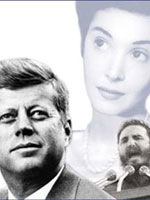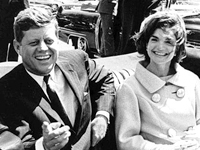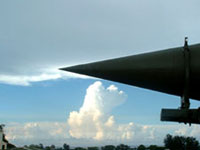1. The defeat of the mercenary Brigade at Bay of Pigs made the U.S. think that the only way of crushing the Cuban Revolution was through a direct military intervention. The U.S. immediately embarked on its preparation. . .
As part of their hostile plans, the U.S. considered a self-inflicted aggression in connection with the Guantanamo Naval Base that would allow them to blame Cuba and provide a pretext for invading the island. With this aim, constant provocations took place from the U.S. side of the base: Marines shooting toward Cuban territory, some times for several hours; the murder of a fisherman.
The number of violations of Cuba's airspace and territorial waters increased. In one single day—July 9th, 1962—U.S. planes flew over Cuban territory 12 times. On another occasion they launched rockets against eastern Cuba territory. U.S. pirate boats attacked unites of the Cuban Revolutionary Navy: three Cubans died during one of those attacks; 17 others were lost in another one.
Meanwhile, Washington stepped up its pressures on Latin American governments so they unconditionally support US plans against Cuba. It accompanie[d] its pressures with bribes: an assistance program for Latin America, the so-called Alliance for Progress, portrayed as a solution for the region’s problems. In late 1961, Venezuela and Columbia broke diplomatic relations with Cuba; in January 1962, the 8th Consultative Meeting of OAS Foreign Ministers, in Punta del Este, Uruguay, suspended Cuba’s membership in the organization for its “incompatibility with the inter-American system.”
Cuba
2. In 1960 the United States took severe economic sanctions against Cuba, refusing to supply oil to the island and cutting back on the purchases of sugar, Cuba's largest and most important export. Forced to make a choice, the Cuban government nationalized the oil industry, sugar processing plants, and other American-owned businesses in Cuba in the summer of 1961. In response, the United States set up an economic blockade of Cuba, stopping trade and prohibiting American tourism to the island. In September 1960 Congress passed a law denying American foreign aid to any nation that assisted Cuba economically or militarily. The ban of tourism alone deprived Cuba of 60 million dollars in annual income and left tens of thousands workers in the service industry unemployed. Finally, in January 1961, U.S. broke off all relations with Cuba. In this dire citation the Soviet Union and other Communist nations stepped in to purchase Cuban sugar and provide the country with oil and other essential goods. By the end of 1960 the Cuban government nationalized most industry, trade, banking, and transportation, taking another step towards becoming a Communist state. Meanwhile the United States pressured and forced other Latin-American nations to break off relations with Cuba.
Russia
3. In 1959, troops led by Fidel Castro toppled a corrupt military regime in Cuba and ushered in a socialist revolution. The Kennedy administration in the United States supported a military expedition to undermine Castro in 1961, but it was decisively repulsed at the Bay of Pigs. In the aftermath of the attempted invasion, Soviet missiles were sent to Cuba. Still rankling from the defeat of the Bay of Pigs and determined to keep the western hemisphere free from communism, Kennedy determined, in October 1962, that the Soviet Union remove its missiles from Cuba. He also called upon his allies to put their NORAD forces on alert in the event the Soviets refused to back down.
Canada
4. On 29 August 1962, high-altitude flights over Cuba by American spy planes showed what might be surface-to-air nuclear missiles being installed in the western provinces by Soviet technicians. Premier Khrushchev assured President Kennedy that his intelligence reports were wrong. But on 14 October, photographs were delivered to the White House which proved that Khrushchev had lied. They clearly showed launching pads and missiles in western Cuba. Why Khrushchev had gone ahead with plans which were bound to endanger the safety of the whole world is not clear. Perhaps the blunders of the Bay of Pigs and the unpopularity of the United States in Latin America had led him to think there was no risk. If so, he was wrong.
Kennedy spent some time discussing his course of action with advisers. He then acted decisively. He informed the OAS (Organization of American States) of the danger from the missiles to both the United States and the Latin republics. He demanded and got OAS support for a plan to stop and search all Soviet ships heading for Cuba. He then contacted Khrushchev and demanded the removal of the missiles. Without waiting for a reply, he ordered 145,000 American troops to stand by in Florida and Nicaragua. Faced with the possibility of clashes which could lead to all-out war, Khrushchev backed down. On 29 October he ordered ships heading for Cuba to turn back and work to start on dismantling missiles on the island.
Caribbean
5. In October 1962, the Soviet Union and the United States went eyeball-to-eyeball and were on the brink of nuclear war. Surveillance photographs taken by a U-2 spy plane over Cuba revealed that the Soviet Union was installing intermediate-range ballistic missiles. Once operational, in about 10 days, the missiles would need only five minutes to reach Washington, D.C. President Kennedy decided to impose a naval blockade. Soviet freighters were steaming toward Cuba. The president realized that if the ships were boarded and their cargoes seized, the Soviet Union might regard this as an act of war. Soviet Premier Khrushchev sent a signal that he might be willing to negotiate. In exchange for the Soviets agreeing to remove the missiles, the United States publicly pledged not to invade Cuba and secretly agreed to remove its aging missiles from Turkey.
After the Cuban Missile Crisis, Cold War tensions eased. In July 1963, the United States, the Soviet Union, and Britain approved a treaty to halt the testing of nuclear weapons in the atmosphere, in outer space, and under water. The following month, the United States and Soviet Union established a hotline providing a direct communication link between the White House and the Kremlin.
United States


